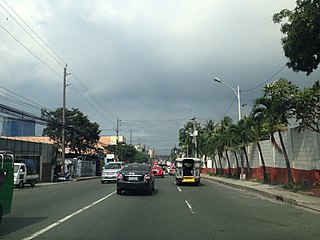
Quezon City, also known as the City of Quezon and Q.C., is the most populous city in the Philippines. It is also the richest city in the Philippines. According to the 2020 census, it has a population of 2,960,048 people. It was founded on October 12, 1939, and was named after Manuel L. Quezon, the second president of the Philippines.

San Pablo, officially the City of San Pablo, is a component city in the province of Laguna, Philippines. According to the 2020 census, it has a population of 285,348 people.

San Jose del Monte, officially the City of San Jose del Monte, is a component city in the province of Bulacan, Philippines. According to the 2020 census, it has a population of 651,813 people, making it the largest local government unit within the province of Bulacan and Central Luzon, and the 18th most populated city in the Philippines.

Mandaluyong, officially the City of Mandaluyong, is a highly urbanized city in the National Capital Region of the Philippines. According to the 2020 census, it has a population of 425,758 people.

Caloocan, officially the City of Caloocan, is a highly urbanized city in Metro Manila, Philippines. According to the 2020 census, it has a population of 1,661,584 people making it the fourth-most populous city in the Philippines.

Candelaria, officially the Municipality of Candelaria, is a municipality in the province of Quezon, Philippines. According to the 2020 census, it has a population of 137,881 people.

San Juan, officially the City of San Juan, is a highly urbanized city in the National Capital Region of the Philippines. According to the 2020 census, it has a population of 126,347 people. It is geographically located at Metro Manila's approximate center and is also the country's smallest city in terms of land area.

Gumaca, officially the Municipality of Gumaca, is a municipality in the province of Quezon, Philippines. According to the 2020 census, it has a population of 71,942 people.

San Jose, officially the Municipality of San Jose, is a municipality in the province of Batangas, Philippines. According to the 2020 census, it has a population of 79,868 people.

Mabini, officially the Municipality of Mabini, is a municipality in the province of Pangasinan, Philippines. According to the 2020 census, it has a population of 26,454 people.

Tiaong, officially the Municipality of Tiaong, is a municipality in the province of Quezon, Philippines. According to the 2020 census, it has a population of 106,265 people.

Unisan, officially the Municipality of Unisan, is a municipality in the province of Quezon, Philippines. According to the 2020 census, it has a population of 25,448 people.

The San Juan River is one of the main river systems in Metro Manila, Philippines, and is a major tributary of the Pasig River. It begins near La Mesa Dam as the San Francisco del Monte River, which officially takes the name San Juan River when it meets with Mariblo Creek in Quezon City. As the San Juan River, it passes through Quezon City, San Juan, the Manila district of Santa Mesa and Santa Ana, and Mandaluyong.

Gregorio Araneta Avenue is a suburban arterial road in the Santa Mesa Heights area of Quezon City, northeastern Metro Manila, Philippines. Constructed in 1985, it is a six-to-eight-lane divided avenue designated as part of Circumferential Road 3 (C-3) and a physical continuation of Sergeant Rivera Street, which travels from Santo Domingo Avenue at its north end near Balintawak in Quezon City and meets N. Domingo Street in the south in San Juan near the border with Santa Mesa, Manila. En route, it intersects with Del Monte Avenue, Quezon Avenue, Eulogio Rodriguez Sr. Avenue and Magsaysay-Aurora Boulevard, passing through barangays Balingasa, Manresa, Masambong, Sienna, Santo Domingo, Talayan, Tatalon, Santol, and Doña Imelda in Quezon City and Progreso in San Juan.

Fernando Poe Jr. Avenue, formerly Roosevelt Avenue, is the principal north–south tertiary road serving the San Francisco del Monte district of Quezon City, Philippines. It is 2.871 kilometers (1.784 mi) long and runs between Epifanio de los Santos Avenue (EDSA) to the north and Quezon Avenue to the south. The avenue is named after Fernando Poe Jr., a renowned Filipino actor and National Artist of the Philippines who once lived along it. Its former name, Roosevelt Avenue, was named after former President of the United States Franklin D. Roosevelt.

Santa Cruz often abbreviated as Sta. Cruz is a barangay located in the San Francisco Del Monte district of Quezon City with an approximate land area of 44 hectares bounded by South and West Triangles in the East, Quezon Avenue and Barangay Paligsahan in the South, Nayong Kanluran in the Northeast and Barangay Paltok in the North.

Bungad is a barangay in Quezon City, Metro Manila, Philippines.

San Francisco del Monte, also referred to as SFDM and Frisco, is a district of Quezon City, Philippines. It is bisected by two major thoroughfares, Fernando Poe Jr. Avenue and the eponymous Del Monte Avenue, and is bounded by Atty. Pat Senador Sr. Street and Baler Street to the north, and Judge Juan Luna Street, Paraiso Street, and Cooper Street to the east.

Mariana is an urban barangay in Quezon City, Metro Manila, Philippines. It is part of a middle class residential development known as New Manila, which includes Barangay Mariana and the adjacent barangays of Damayang Lagi, Horseshoe, and Valencia.

The Basilica Minore de San Pedro Bautista, also known as the San Francisco del Monte Church and alternatively as Santuario de San Pedro Bautista, is a minor basilica and parish church in the San Francisco del Monte district of Quezon City, Philippines. It is one of the oldest churches in the country and the oldest in the city, having been founded in 1590. The church is dedicated to its founder Padre Pedro Bautista, a Spanish missionary from Ávila, Spain, one of the 26 Christians martyred in Japan in 1597.
























